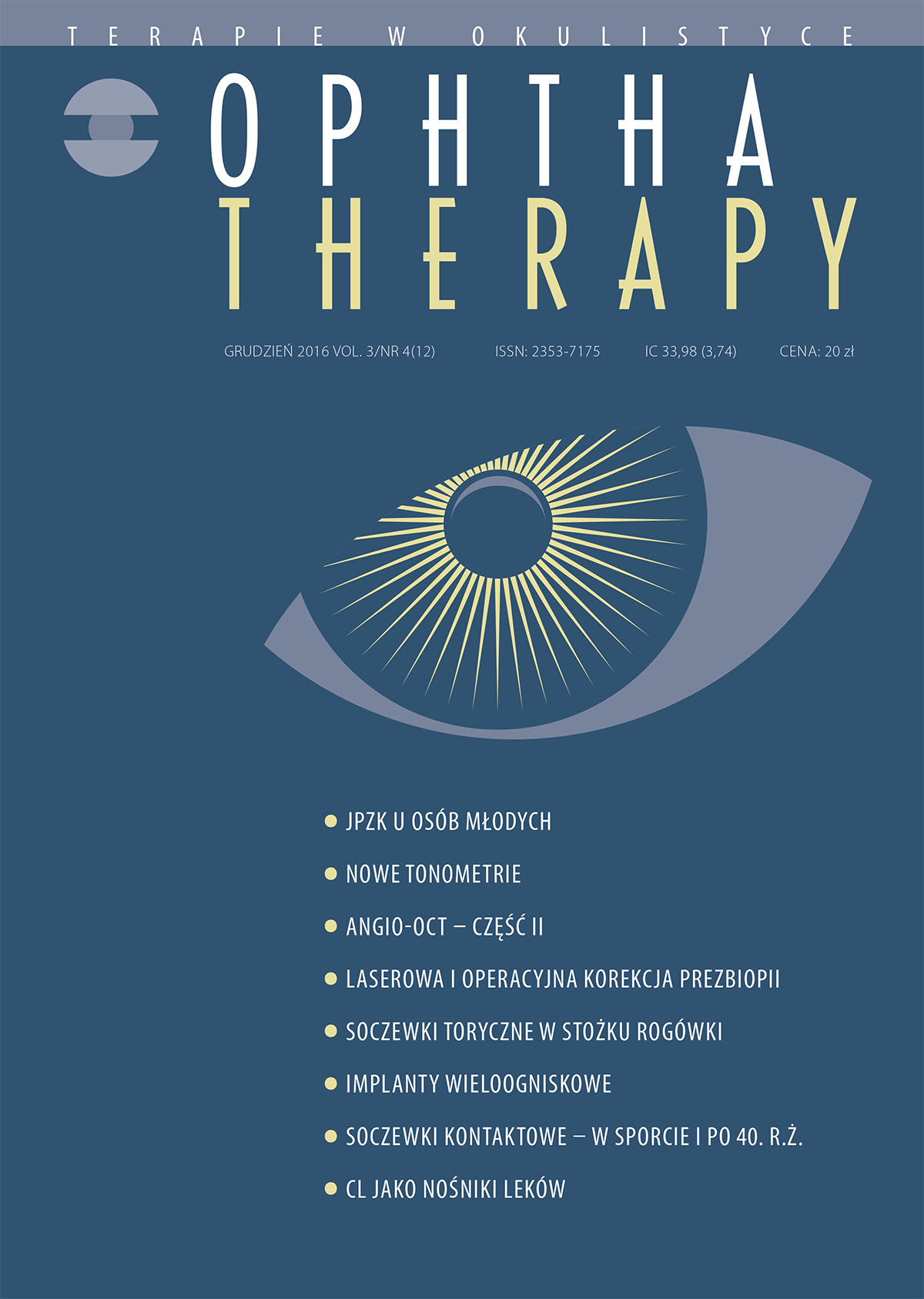Postoperative presbyopia correction with intraocular lenses implantation in cataract patients – current trends
Main Article Content
Abstract
The most popular method of presbyopia correction during cataract surgery involves multifocal intraocular lens implantation. The MIOLs (multifocal intraocular lenses) constitute less than 5% of the intraocular lens market. With MIOLs patients can achieve very good distance, intermediate, and near vision, but very often accompanied by negative side effects. The most bothersome drawbacks of MIOLs include the night-light phenomena and low contrast sensitivity, mainly in low-light conditions. The main trends in MIOL technology developments involve achieving proper balance between good vision at all distances and spectacle independence, and lower contrast sensitivity and presence of negative light phenomena. Over the recent years, due to the changes to our lifestyle, intermediate vision (60–80 cm) has become very important, as has the development of trifocal and EDOF (extended depth of focus) lenses. New designs of diffractive lenses enable higher transmittance of light energy through the optics and the possibility of correcting the chromatic aberration which influences contrast sensitivity, especially in low light conditions. The echelette design makes it possible to eliminate the very disturbing night light phenomena thanks to the elongated focus. Nowadays, modern multifocal intraocular lenses allow patients to achieve very good vision at all distances after cataract surgery without troublesome side effects. And for that reason, multifocals can be used in a wider population of cataract patients, offering them high levels of satisfaction and spectacle independence.
Downloads
Article Details

This work is licensed under a Creative Commons Attribution-NonCommercial-NoDerivatives 4.0 International License.
Copyright: © Medical Education sp. z o.o. License allowing third parties to copy and redistribute the material in any medium or format and to remix, transform, and build upon the material, provided the original work is properly cited and states its license.
Address reprint requests to: Medical Education, Marcin Kuźma (marcin.kuzma@mededu.pl)
References
2. Braga-Mele R, Chang D, Dewey S et al; for the ASCRS Cataract Clinical Committee. Multifocal intraocular lenses: relative indications and contraindications for implantation. J Cataract Refract Surg. 2014; 40: 313-22.
3. Rajan MS, Keilhorn I, Bell JA. Partial coherence laser interferometry vs conventional ultrasound biometry in intraocular lens power calculations. Eye. 2002; 16: 552-6.
4. Findl O, Kriechbaum K, Sacu S et al. Influence of operator experience on the performance of ultrasound biometry compared to optical biometry before cataract surgery. J Cataract Refract Surg. 2003; 29: 1950-5.
5. Koch DD, Ali SF, Weikert MP et al. Contribution of posterior corneal astigmatism to total corneal astigmatism. J Cataract Refract Surg. 2012; 38: 2080-7.
6. de Vries NE, Webers CAB, Touwslager WRH et al. Dissatisfaction after implantation of multifocal intraocular lenses. J Cataract Refract Surg. 2011; 37: 859-65.
7. de Vries NE, Nujits RM. Multifocal intraocular lenses in cataract surgery: literature review of benefits and side effects. J Cataract Refract Surg. 2013; 39: 268-78.
8. Hamid A, Sokwala A. A More Natural Way of Seeing: Visual Performance of Three Presbyopia Correcting Intraocular Lenses. Open J Ophthalmol. 2016; 6: 176-83.
9. Auffarth GU, Kretz FTA. The Evaluation of New Presbyopia-Correcting IOLs. Cataract & Refractive Surgery Today Europe 2015; January: 51-9.
10. Ang RE, Martinez GA, Cruz EM et al. Prospective evaluation of visual outcomes with three presbyopia-correcting intraocular lenses following cataract surgery. Clin Ophthalmol. 2013; 7: 1811-23.
11. Pepose JS, Burke J, Qazi MA. Benefits and barriers of accommodating intraocular lenses. Curr Opin Ophthalmol. 2016. http://dx.doi.org/10.1097/ICU.0000000000000323.
12. Dhital A, Spalton DJ, Gala KB. Comparison of near vision, intraocular lens movement, and depth of focus with accommodating and monofocal intraocular lenses. J Cataract Refract Surg. 2013; 39: 1872-8.
13. Zamora-Alejo KV, Moore SP, Parker DGA et al. Objective accommodation measurement of the Crystalens HD compared to monofocal intraocular lenses. J Refract Surg. 2013; 29: 133-9.
14. Pedrotti E, Bruni E, Bonacci E et al. Comparative Analysis of the Clinical Outcomes With a Monofocal and an Extended Range of Vision Intraocular Lens. J Refract Surg. 2016; 32(7): 436-42.
15. Cochener B. Prospective Clinical Comparison of Patient Outcomes Following Implantation of Trifocal or Bifocal Intraocular Lenses. J Refract Surg. 2016; 32(3): 146-51.
16. Cochener B, Vryghem J, Rozot P et al. Clinical outcomes with a trifocal intraocular lens: a multicenter study. J Refract Surg. 2014; 30(11): 762-8.
17. Vryghem JC, Heireman S. Visual performance after the implantation of a new trifocal intraocular lens. Clin Ophthalmol. 2013; 7: 1957-65.
18. Wilkins MR, Allan BD, Rubin GS et al; Moorfields IOL Study Group. Randomized trial of multifocal intraocular lenses versus monovision after bilateral cataract surgery. Ophthalmology. 2013; 120(12): 2449-55.
19. Ito M, Shimizu K. Reading ability with pseudophakic monovision and with refractive multifocal intraocular lenses: comparative study. J Cataract Refract Surg. 2009; 35(9): 1501-4.
20. Hayashi K, Hayashi H. Stereopsis in bilaterally pseudophakic patients. J Cataract Refract Surg. 2004; 30(7): 1466-70.
21. Hamid A. Visual performance of three presbyopia-correcting intraocular lenses. Copenhagen ePoster Pseudophakic IOLs; Enlarged Depth of Focus 2016.
22. Bronicki D, Miller M, Dyda W et al. Pseudosoczewkowość po operacji zaćmy nie musi ograniczać. Soczewka trójogniskowa jako rozwiązanie problemu starczowzroczności. OphthaTherapy. 2015; 4(8): 286-91.

